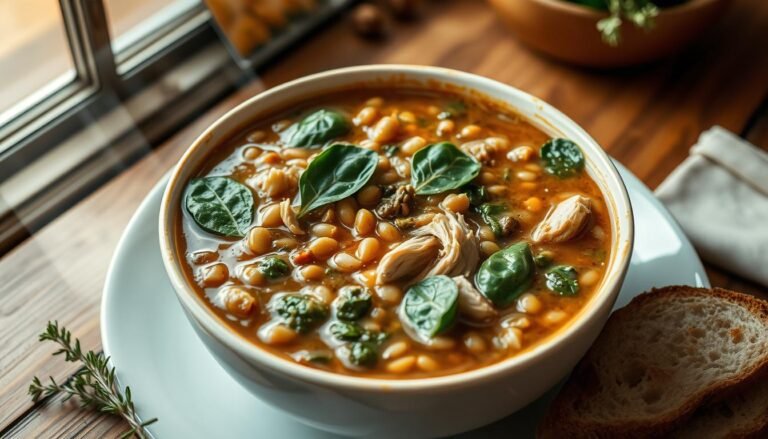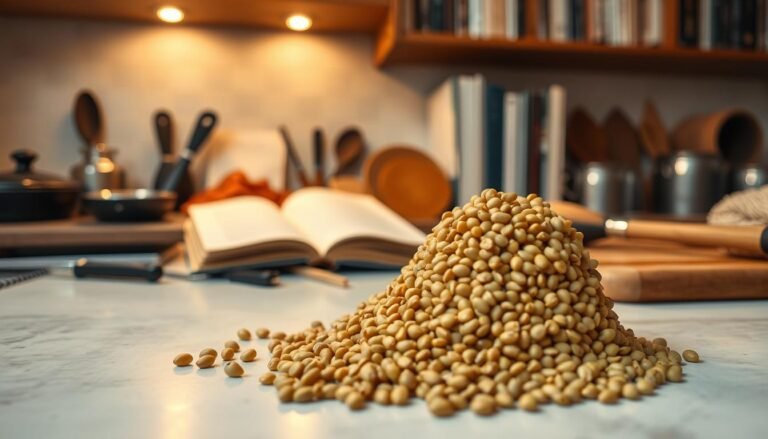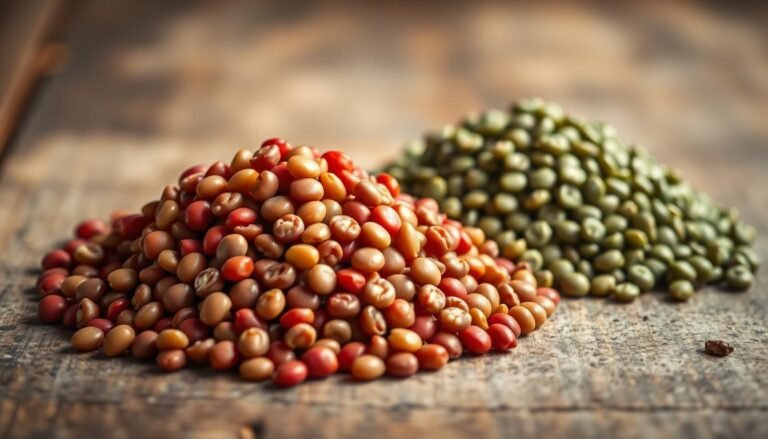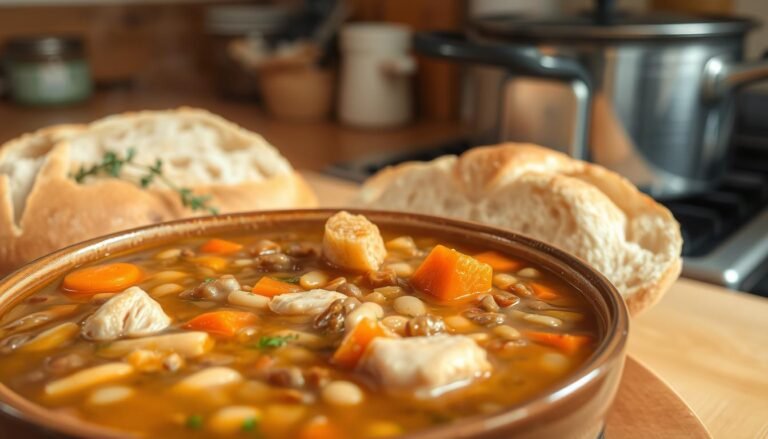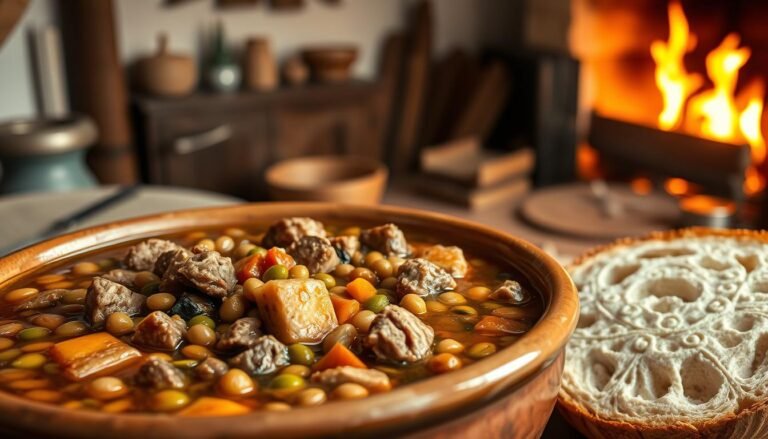Making homemade pasta is an art that has been perfected in Italian cuisine for centuries. With a simple pasta recipe, you can create delicious dishes that are sure to impress.
By making pasta from scratch, you can control the ingredients and texture, ensuring a truly authentic Italian experience. Our guide will walk you through the process, providing you with the skills and confidence to create mouth-watering pasta dishes.
Key Takeaways
- Learn the basics of making homemade pasta
- Discover the benefits of creating pasta from scratch
- Explore the world of Italian cuisine with our simple pasta recipe
- Improve your cooking skills with our step-by-step guide
- Create delicious and authentic Italian dishes
The Rich History of Pasta Making
Understanding the history of pasta can enrich our appreciation of this beloved dish. Pasta making has evolved significantly over time, influenced by various cultures and culinary traditions.
Origins in Ancient Civilizations
Pasta’s origins trace back to ancient civilizations, where early forms of pasta were consumed in the Mediterranean region. The Italians are credited with perfecting pasta making, turning it into a staple of Italian cuisine. Archaeological findings suggest that ancient Greeks and Romans consumed dishes made from barley or wheat flour, laying the groundwork for modern pasta.
Evolution of Pasta Through the Centuries
As trade and exploration expanded, pasta spread throughout Europe and beyond. By the Middle Ages, pasta had become a significant part of Italian culinary culture, with various regions developing their unique pasta shapes and recipes. This evolution continued as Italian immigrants brought their pasta-making traditions to new lands, including Australia.
Pasta in Modern Australian Cuisine
In modern Australian cuisine, pasta has become a popular dish, blending Italian roots with local flavors. Australian restaurants and home cooks alike experiment with pasta, incorporating native ingredients and modern twists into traditional recipes. This fusion reflects the multicultural nature of Australian society and its openness to diverse culinary influences.
| Period | Pasta Evolution | Culinary Influence |
|---|---|---|
| Ancient Times | Early forms of pasta consumed | Mediterranean diet |
| Middle Ages | Regional pasta shapes emerge | Italian cuisine |
| Modern Era | Pasta integrates into local cuisine | Australian cuisine |
Why Homemade Pasta Outshines Store-Bought Varieties
There’s a significant difference between homemade and store-bought pasta, with the former offering a more authentic Italian experience. Making pasta from scratch allows for a level of quality and customization that’s often lacking in commercial products.
Texture and Flavor Differences
One of the primary advantages of homemade pasta is its superior texture and flavor. Unlike store-bought pasta, which can be dry and bland, freshly made pasta has a tender bite and a more complex flavor profile. This is due to the use of fresh ingredients and the ability to control the cooking time precisely.
The texture of homemade pasta is often described as more delicate and refined, making it a perfect base for a variety of sauces. Moreover, the flavor of the pasta itself is enhanced when made with high-quality ingredients and care.
| Characteristics | Homemade Pasta | Store-Bought Pasta |
|---|---|---|
| Texture | Tender, delicate | Dry, sometimes rough |
| Flavor | Rich, complex | Blunt, less nuanced |
| Customization | Highly customizable | Limited options |
Customization Possibilities
Homemade pasta offers endless possibilities for customization. By adjusting the ingredients, you can create pasta that suits various dietary needs and preferences. For instance, using different types of flour can significantly alter the nutritional content and flavor of the pasta.
Additionally, you can infuse the pasta with various flavors by adding herbs, spices, or vegetables to the dough. This level of customization is not easily achievable with store-bought pasta.
The Satisfaction of Creating From Scratch
Making pasta from scratch can be a therapeutic and rewarding experience. The process of creating something with your own hands can be very satisfying, and the end result is a delicious meal that you can be proud of.
Furthermore, involving family or friends in the pasta-making process can make it a fun and memorable activity. It’s a great way to spend quality time together while creating something delicious.
Essential Ingredients for Perfect Homemade Pasta
The foundation of excellent homemade pasta lies in the quality and type of ingredients used in its creation. Making pasta from scratch is not just about mixing flour and eggs; it’s about understanding how different components contribute to the final product’s texture, flavor, and overall quality.
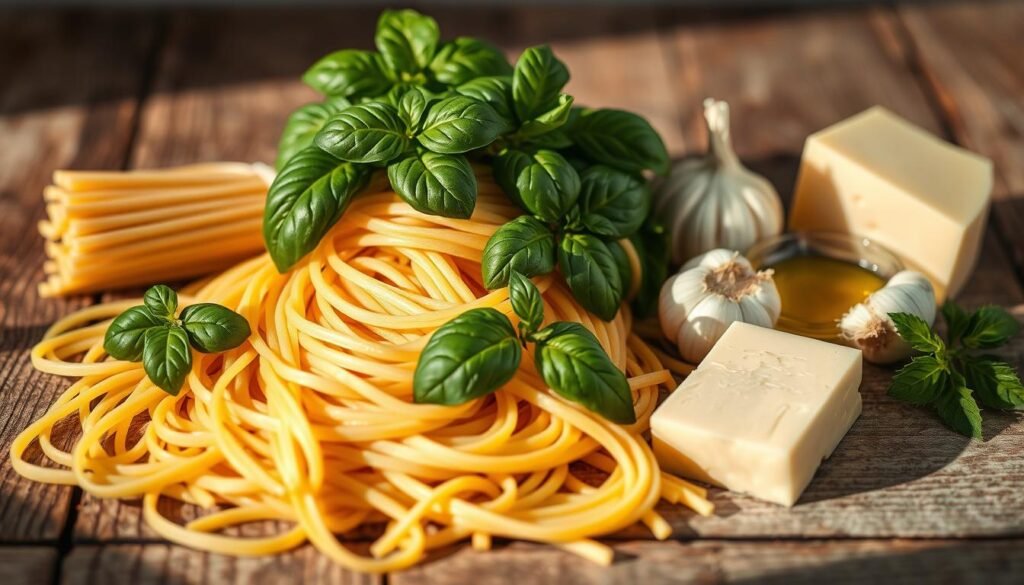
Flour Options and Their Effects on Pasta
The type of flour used is crucial in pasta making. ’00’ flour, or Caputo flour, is a popular choice among pasta enthusiasts due to its fine texture and low protein content, which results in tender yet firm pasta. All-purpose flour can also be used, especially for those just starting out, as it provides a good balance between strength and delicacy. For a more nuanced flavor, some pasta makers prefer using semolina flour, which gives pasta a slightly yellow hue and a more robust taste.
The Role of Eggs in Pasta Dough
Eggs play a vital role in pasta dough, acting as a binder and adding richness to the pasta. The number of eggs used can vary depending on the recipe and the desired consistency of the dough. Generally, a ratio of one egg to 100 grams of flour is a good starting point. Eggs not only contribute to the color and flavor of the pasta but also affect its texture, making it more supple and easier to work with.
Salt, Olive Oil, and Other Additions
Salt and olive oil are common additions to pasta dough. Salt enhances the flavor of the pasta, while olive oil can improve the dough’s texture by reducing stickiness and adding a subtle flavor. Some recipes also include additional ingredients like herbs or vegetable purees to create flavored pasta. These ingredients can significantly alter the character of the pasta, offering endless possibilities for creativity in the kitchen.
By carefully selecting and combining these essential ingredients, pasta makers can create a wide variety of homemade pasta that caters to different tastes and preferences. Whether you’re aiming for a traditional Italian flavor or experimenting with new ingredients, the quality of your pasta will ultimately depend on the quality of its components.
Kitchen Equipment You’ll Need
Before diving into the world of homemade pasta, it’s essential to equip your kitchen with the right tools. Making pasta from scratch doesn’t require a plethora of gadgets, but having the correct equipment can significantly simplify the process and enhance the quality of your final product.
Must-Have Tools for Beginners
For those just starting out, a few key pieces of equipment are indispensable. A large mixing bowl for combining ingredients, a measuring jug for accurate measurements, and a wooden spoon or spatula for mixing are the basics. A clean surface for kneading is also crucial, as is a sharp knife or pasta cutter for cutting your pasta to the desired shape.
A stand mixer or hand mixer can be a valuable asset for initial dough mixing, saving time and effort. However, it’s not a necessity; a sturdy arm can accomplish the same task manually.
Optional Equipment for Enthusiasts
For those who become more serious about pasta making, investing in a pasta machine can be a game-changer. It allows for precise control over the thickness of your pasta, enabling you to achieve the perfect al dente texture. Additionally, a pasta drying rack can be useful for drying freshly cut pasta, helping to prevent sticking and ensuring your pasta dries evenly.
Making Do With What You Have
It’s worth noting that you don’t need to rush out and buy specialized equipment to start making homemade pasta. Many kitchens already have the basic tools needed. A rolling pin can substitute for a pasta machine in a pinch, and a sharp kitchen knife can be used to cut your pasta. The key is to start simple and upgrade your equipment as you become more comfortable with the pasta-making process.
Step-by-Step Homemade Pasta Recipe
Making homemade pasta from scratch can be a rewarding experience, and with the right guidance, you can create delicious pasta in the comfort of your own kitchen. To start, you’ll need a few simple ingredients and some basic kitchen equipment.
Creating the Perfect Dough
The foundation of great homemade pasta is the dough. To create the perfect dough, you’ll need to combine ’00’ flour, eggs, and a pinch of salt in a mixing bowl. The ratio of flour to eggs is crucial, so it’s essential to get this step right. For a basic recipe, you can follow the guidelines provided by Jamie Oliver’s fresh egg pasta recipe.
Using a fork, gently mix the ingredients together until the dough starts to come together. Be careful not to overmix at this stage, as it can lead to a tough dough.
Kneading Techniques for Optimal Texture
Once you have your dough, it’s time to knead. Kneading is a critical step in developing the gluten in the dough, which will give your pasta its signature texture. To knead effectively, use the heel of your hand to push down on the dough, then fold it back up and repeat. This process should be repeated for around 10 minutes, until the dough becomes smooth and elastic.
Resting the Dough: Why It Matters
After kneading, it’s essential to let the dough rest. This allows the gluten to relax, making the dough easier to roll out and shape. To rest the dough, simply wrap it in plastic wrap or a damp cloth and let it sit at room temperature for at least 30 minutes. This step is crucial in creating a smooth, even texture in your finished pasta.
Rolling and Cutting Your Pasta
Once your pasta dough is ready, the next crucial steps are rolling and cutting it into the desired shapes. This stage is where your patience and skill come together to create the perfect pasta.
Hand-Rolling Techniques
Hand-rolling pasta dough is a traditional method that requires some elbow grease but yields satisfying results. To start, divide your rested dough into manageable portions. Using a rolling pin, roll out the dough to your desired thickness, typically around 1/16 of an inch for most pasta shapes. It’s essential to maintain even pressure to achieve a uniform thickness across the dough.
As you roll, periodically lift and turn the dough to prevent it from sticking to your surface. If necessary, lightly dust your work surface with flour. The goal is to achieve a smooth, translucent sheet of dough that is not too thin, as this can lead to pasta that’s too delicate.
Using a Pasta Machine Effectively
A pasta machine is a valuable tool for achieving consistent results. Begin by setting the machine to its widest setting and passing your dough through it. Gradually decrease the thickness with each pass, folding the dough in half if necessary, until you reach your desired thickness.
It’s crucial to clean your pasta machine regularly to prevent dough from sticking to it. After each use, brush off any remaining flour and oil the machine if recommended by the manufacturer. This maintenance ensures smooth operation and longevity of your pasta machine.
Cutting Different Pasta Shapes
With your dough rolled out, it’s time to cut it into various pasta shapes. You can use a pasta cutter attachment on your machine, a sharp knife, or specialized pasta cutters. For instance, fettuccine and spaghetti are cut into long, thin strands, while pappardelle is wider and more rustic.
For those new to pasta making, starting with simple shapes like tagliatelle or pappardelle can be less intimidating. As you gain experience, you can experiment with more complex shapes like farfalle or tortellini.
Drying and Storing Fresh Pasta
Proper drying and storage are essential steps in preserving the freshness and flavor of your freshly made pasta. After you’ve rolled and cut your pasta, it’s crucial to dry it thoroughly to prevent moisture from causing it to stick together or become a breeding ground for bacteria.
Proper Drying Methods
Drying your pasta correctly is the first step in storing it. You can air-dry pasta by laying it out on a clean towel or pasta drying rack. It’s essential to ensure that the pasta is not overlapping, allowing air to circulate around each piece. For more delicate shapes, consider using a pasta drying rack with multiple tiers to maximize airflow.
Short-Term Storage Solutions
Once your pasta is dry, you can store it in airtight containers for short-term use. Glass jars or plastic containers with tight-fitting lids work well. Make sure to store them in a cool, dry place, away from direct sunlight. Your pasta can last for several days when stored properly.
Freezing Homemade Pasta for Later Use
For longer storage, freezing is an excellent option. Place your dried pasta in a single layer on a baking sheet and put it in the freezer. Once frozen, transfer the pasta to airtight containers or freezer bags, making sure to remove as much air as possible before sealing. Frozen pasta can be cooked directly from the freezer; just add a minute or two to the cooking time.
Tip: Label your containers or bags with the date and type of pasta for easy identification later.
Cooking Your Homemade Pasta to Perfection
The key to enjoying your homemade pasta lies in cooking it to perfection. Cooking pasta may seem straightforward, but there are several factors to consider to achieve that ideal al dente texture.
Boiling Times for Different Pasta Thicknesses
The thickness of your pasta significantly affects its cooking time. Generally, the thicker the pasta, the longer it takes to cook. For instance, thin pasta shapes like capellini or spaghetti may cook in as little as 2-3 minutes, while thicker shapes like pappardelle or lasagna sheets can take up to 5-7 minutes.
| Pasta Thickness | Approximate Cooking Time |
|---|---|
| Thin (0.8-1 mm) | 2-3 minutes |
| Medium (1.2-1.5 mm) | 3-4 minutes |
| Thick (1.8-2 mm) | 5-7 minutes |
The Importance of Well-Salted Water
Using well-salted water is crucial when cooking pasta. Salt not only adds flavor but also helps to season the pasta from the inside out. A general rule of thumb is to use about 1-2 tablespoons of salt for every 4 cups of water. This will ensure your pasta is well-seasoned and cooks evenly.
Testing for Doneness: The Al Dente Sweet Spot
Achieving the perfect doneness is key to enjoying your homemade pasta. The term “al dente” refers to pasta that is cooked until it still has a bit of bite or chew. To test for doneness, remove a piece of pasta from the boiling water and taste it. It should be firm but not hard. If it’s too soft, it’s overcooked.
Tips for achieving al dente:
- Start checking for doneness a minute or two before the recommended cooking time.
- Use a slotted spoon to remove pasta from the water for tasting.
- Remember that pasta will continue to cook a bit after being drained.
Cooking your homemade pasta to perfection requires attention to detail, but with practice, you’ll get the hang of it. By following these guidelines, you’ll be able to enjoy your freshly made pasta at its best.
Classic Sauce Pairings for Fresh Pasta
The art of pairing sauce with fresh pasta is a culinary journey worth exploring. Fresh pasta, with its delicate texture and neutral flavor, provides a perfect canvas for a variety of sauces. The key to a great pairing lies in understanding the characteristics of both the pasta and the sauce.
Simple Tomato-Based Sauces
Simple tomato-based sauces are a staple in Italian cuisine. Made with fresh tomatoes, garlic, olive oil, and herbs like basil, these sauces are light, refreshing, and complement the delicate flavor of fresh pasta. For a quick and delicious sauce, try making a spaghetti with vine tomato sauce, basil, and. The acidity of the tomatoes cuts through the richness of the pasta, creating a balanced flavor profile.

Creamy Sauce Options
Creamy sauces, on the other hand, offer a rich and indulgent contrast to the lightness of fresh pasta. Made with ingredients like heavy cream, Parmesan cheese, and butter, these sauces coat the pasta, providing a luxurious texture. Popular creamy sauce options include Alfredo and Carbonara. The key to a great creamy sauce is to balance the richness with a touch of seasoning, such as black pepper or nutmeg.
Oil-Based and Light Sauces
For those looking for a lighter option, oil-based sauces are an excellent choice. These sauces typically feature olive oil as the base, infused with flavors from garlic, herbs, and sometimes chili flakes. They are perfect for delicate pasta shapes and can be made more substantial with the addition of ingredients like cherry tomatoes or grilled vegetables. The simplicity of oil-based sauces allows the natural flavor of the pasta to shine while adding a layer of flavor.
| Sauce Type | Key Ingredients | Pasta Pairing |
|---|---|---|
| Tomato-Based | Tomatoes, garlic, olive oil, basil | Spaghetti, Pappardelle |
| Creamy | Heavy cream, Parmesan, butter | Fettuccine, Tagliatelle |
| Oil-Based | Olive oil, garlic, herbs, chili flakes | Linguine, Capellini |
Experimenting with different sauce pairings is a fun and creative way to enjoy fresh pasta. Whether you prefer the simplicity of a tomato sauce, the richness of a creamy sauce, or the lightness of an oil-based sauce, there’s a perfect pairing waiting to be discovered.
Troubleshooting Common Pasta Making Problems
Pasta enthusiasts often encounter a few common problems when making homemade pasta. Whether you’re a beginner or an experienced pasta maker, issues like sticky dough, dry or crumbly pasta, and cooking mishaps can be frustrating. Fortunately, many of these problems have simple solutions.
Dealing With Sticky Dough
Sticky dough is a common issue when making pasta. To combat this, ensure you’re using the right type of flour, such as “00” flour or caputo flour, which has a lower protein content. If your dough is still sticky, try adding a small amount of flour and kneading it in. Avoid adding too much flour, as this can lead to tough pasta. Another tip is to knead the dough long enough to develop the gluten properly, which can help the dough become less sticky.
- Use the right type of flour
- Add flour gradually if dough is sticky
- Knead the dough sufficiently
Fixing Dry or Crumbly Pasta
Dry or crumbly pasta can be a result of overworking the dough or using too much flour. To fix this, try adding a small amount of water or egg to the dough and kneading it in. It’s also essential to ensure that you’re not over-rolling the pasta, as this can cause it to become too thin and fragile. If you’re using a pasta machine, start at a thicker setting and gradually decrease the thickness as you roll.
“The key to making great pasta is in the kneading and rolling. With a bit of practice, you’ll get the hang of it.”
Addressing Cooking Issues
Cooking pasta can sometimes be tricky, but there are a few tips to ensure it turns out perfectly. First, make sure you’re using a large pot of well-salted water. Bring the water to a rolling boil before adding the pasta, and stir gently to prevent sticking. Cook the pasta until it’s al dente, then drain and serve immediately.
Creative Variations to Try
Once you’ve mastered the basics of pasta making, it’s time to get creative with new flavors and ingredients. Experimenting with different elements can help you create unique dishes that reflect your personal taste and style.
Herb and Vegetable Infused Pastas
Infusing pasta dough with herbs and vegetables not only adds flavor but also creates visually appealing colors. Try adding spinach puree for a vibrant green color or beetroot juice for a deep red hue. Fresh herbs like basil or parsley can be finely chopped and mixed into the dough for added freshness. These variations can elevate your pasta dishes and make them stand out.
Alternative Flour Pasta Recipes
While traditional pasta is made with all-purpose flour, experimenting with alternative flours can yield interesting results. Whole wheat flour adds a nuttier flavor, while spelt flour provides a slightly sweet taste. For those with dietary restrictions, gluten-free flours can be used, though they may require additional ingredients like xanthan gum to achieve the right texture.
Filled Pasta Techniques
Filled pasta, such as ravioli and tortellini, offers endless possibilities for creative fillings. From classic ricotta and spinach to more adventurous options like roasted butternut squash, the filling can greatly impact the final dish. Ensuring the pasta is sealed properly is crucial to prevent fillings from escaping during cooking.
Nutritional Benefits of Homemade Pasta
Unlike commercial pasta, homemade pasta can be made with wholesome ingredients, enhancing its nutritional benefits. This difference is significant for individuals seeking to improve their diet through better carbohydrate choices.
Comparing Nutrition With Commercial Options
Commercial pasta often contains preservatives and undergoes processing that can reduce its nutritional value. In contrast, homemade pasta is made fresh, typically with just a few ingredients like flour, eggs, and salt. This simplicity not only ensures a cleaner ingredient list but also allows for the incorporation of nutrient-rich ingredients. For instance, using whole wheat flour instead of refined flour increases the fiber content, while adding vegetables or herbs can boost vitamin and mineral levels.
Modifications for Dietary Restrictions
One of the significant advantages of homemade pasta is the ability to modify recipes to accommodate various dietary restrictions. For gluten-free pasta, alternative flours such as almond or rice flour can be used. For those following a vegan diet, eggs can be replaced with flaxseed or other egg substitutes. Additionally, incorporating different types of flour or adding nutritious ingredients like spinach or beetroot can enhance the nutritional profile of the pasta, making it suitable for a wide range of dietary needs.
Conclusion: Embracing the Art of Pasta Making
Practicing and experimenting with different pasta making techniques is essential to becoming a skilled pasta maker. As you continue to hone your skills, you’ll discover the joy of creating delicious, homemade pasta that rivals Italian cuisine.
By mastering various cooking techniques, you’ll be able to craft a wide range of pasta dishes that cater to different tastes and preferences. Whether you’re making a simple spaghetti dish or a complex filled pasta, the art of pasta making is a rewarding experience.
As you explore the world of pasta making, don’t be afraid to try new ingredients and techniques. With time and practice, you’ll develop your own unique style and flair, allowing you to create authentic Italian-inspired dishes in the comfort of your own kitchen.
